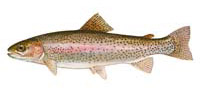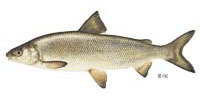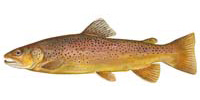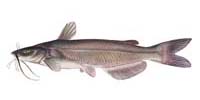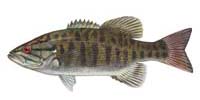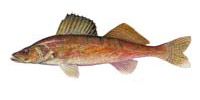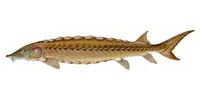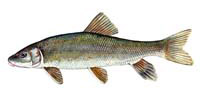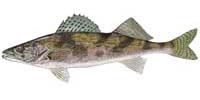Take a trip to Yellowstone River where you’ll find internationally renowned trout fishing. The upper half of these premier trout waters include abundant numbers of cutthroat trout, rainbow trout, whitefish, and brown trout. The river changes in the lower half to a warmwater fishery where you can find big walleye, sturgeon, and catfish. You can fish the waters of Yellowstone River from the shore, but your best bet is to use a boat. This will give you several advantages. First, the upper half of the river has swiftly moving waters and is generally very wide. Secondly, it can also get quite deep. When you combine deep, wide, and swiftly moving waters, it can make wading to a good fishing spot extremely difficult. For this reason, fishing from a boat is your safest and best option.
Fishing Locations
Yellowstone River offers a diversity of fishing opportunities and locations. The river can be broken down to different sections based on landscape, water conditions and fishing opportunities.
Headwaters
The headwaters of Yellowstone are upstream of the Yellowstone Lake. Fishing is best in this large stretch of river from mid-July to mid-September. From the Yellowstone Lake to the falls, cutthroats can reach around twenty-three inches.
Grand Canyon and Black Canyon
If you don’t mind hiking, fish around Yellowstone’s Grand Canyon and the Black Canyon. A lot of cutthroats are found here but they aren’t as big as the cutthroat found around Yellowstone falls. You’ll also find a few brown trout and rainbow trout in these canyons. Fishing is best after the runoff during late summer and early fall.
Gardiner to Yankee Jim Canyon
Fishing activity is high along this stretch of the river. Here anglers will find a large number of cutthroats, and healthy number of rainbows and browns. Dry fly fishing is most effective for catching cutthroats. Baetis and caddis hatches are plentiful along this expanse of the river during the springtime. Near the end of July, hopper fishing begins. Fishing is good here even in the fall when the mayflies attract fish to the surface on cloudy days. Gardiner to Yankee Jim Canyon also produces excellent salmon fly fishing. Use caution when floating in Yankee Jim Canyon, as the whitewater in this area can get very intense.
Yankee Jim Canyon
After Yankee Jim Canyon, the river drops and enters Paradise Valley. Large brown trout can be caught in this area, some nearing fifteen pounds. Rainbows are also plentiful with a few browns. This section of the river has a lot of whitewater can be dangerous for inexperienced boaters. If you plan on floating this section of the river, rafts are preferable to drift boats that don’t handle rapids as well.
Livingston
This section of the river, locally referred to as the “Town Stretch”, extends from Mallard’s Rest to the 89 bridge. It has unique character and contours, including eddies, riffles, multiple channels and shelves. The Town Stretch is known for producing some of the highest concentrations of rainbow trout of any section of the Yellowstone River. It’s also known for producing some large browns. Fishing here is best when river levels are lower.
The Lower Yellowstone River
The lower section of the Yellowstone river runs from the 89 bridge to Reed Point as it leaves the Livingston stretch. With more channels feeding the river, it continues to grow as heads toward the city of Big Timber. Throughout Yellowstone river, there are fewer Brown trout than Rainbows or Cutthroats. However, along the Lower section of Yellowstone River Browns tend to be stable in numbers. They also tend to be the largest trout species in the river, with exception of the occassional monster Rainbow.
Fishing Seasons
When fishing Yellowstone river, knowing when to fish is almost as important knowing where to fish. Below we’ll explore the different seasons and how they impact fishing on Yellowstone River.
Spring
Spring on Yellowstone River offers is between April and May and provides excellent fishing. This season is before the major run off while river levels are lower. The action gets exciting as the baetis mayflies show up, drawing hungry trout to the surface to the surface to feed. During early spring, the Mother’s Day caddis hatch also gets into full swing attracting hungry trout and anxious anglers.
Summer (Early and Late)
Early summer occurs post run off when waters levels are higher and river flow has increased. However, river levels, both pre- and post-runoff, vary greatly depending on snow pack from the previous winter. Following the run off the Yellowstone river offers some of the best summer fishing in Montana. Nymph fishing or fishing with streams work well when river flow reaches 8,000-10,000 cubic feet per (cfs) second. At 8,000 cfs or lower, attractor dry fly fishing—using foam attractors that resemble salmon flies and golden stones—are ideal for targeting trout.
During late summer as the majority of hatches subside, hopper fishing becomes ideal for catching trout. Both hoppers and ants are major natural food source for Yellowstone trout during late summer. The nocturnal stonefly nymph also hatches during late summer. Flies resembling stonefly nymphs work well during stonefly hatches.
Fall
From September through early November, the largest trout in Yellowstone, big Browns, let down their guard to spawn. During this time they respond well to large streamers. During the fall season, dry flies are also particularly effective. Fishing pressure from other anglers is low during the fall making it a prime time to fish the Yellowstone River.
Yellowstone River Fish:
Yellowstone River boat ramps:
The following boat ramps provide access to Yellowstone River.


